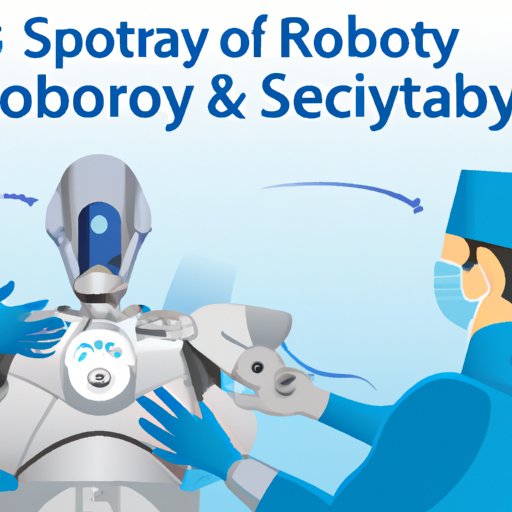Introduction
Robot assisted surgery is a type of minimally invasive surgery that uses robotic technology to perform complex operations. This type of surgery has been around since the early 2000s and is becoming increasingly popular due to its precision and accuracy. In this article, we will explore the various aspects of robot assisted surgery, including its benefits, technology and pros & cons in comparison to traditional surgery.

Exploring the Benefits of Robot Assisted Surgery
Robot assisted surgery offers many benefits over traditional surgical procedures. The most notable benefit of this type of surgery is improved accuracy and precision. Using robotic arms, surgeons are able to make precise, small incisions that are impossible to make with the human hand. This allows for more effective and accurate surgery, resulting in better outcomes for patients.
Another benefit of robot assisted surgery is that it reduces the risk of complications. By using smaller incisions, there is less tissue trauma and fewer risks of infection. This leads to shorter recovery times and reduced hospital stays. Additionally, robot assisted surgery can be used to perform delicate procedures that would otherwise be difficult or impossible with traditional techniques.
An Overview of Robot Assisted Surgery
Robot assisted surgery is used to perform a variety of procedures, including hysterectomies, prostatectomies, colorectal surgeries and cardiac surgeries. It is also used to treat cancerous tumors and other conditions. The procedure involves the use of a robotic system that is controlled by a surgeon. The robot is equipped with a 3D camera that provides a detailed view of the surgical site, allowing for more precise movements.
During the operation, the surgeon sits at a console where they control the robotic arms. The arms are equipped with specialized tools such as scalpels and forceps. The surgeon is able to see the surgical site in real time, giving them greater control over the procedure. The robot is also able to make tiny incisions, meaning the patient experiences less pain and bleeding during the operation.

Understanding the Pros and Cons of Robot Assisted Surgery
Robot assisted surgery has both advantages and disadvantages when compared to traditional surgery. One of the main advantages is that it allows for more precise and accurate surgery, resulting in better outcomes for patients. Additionally, robot assisted surgery typically requires fewer incisions, meaning there is less tissue trauma and a shorter recovery time.
However, there are some drawbacks to this type of surgery. One of the main disadvantages is the cost. Robot assisted surgery is still relatively new and therefore can be expensive. Additionally, it is not suitable for all types of procedures, and some surgeons may not have experience with this type of surgery.
Examining the Technology Behind Robot Assisted Surgery
Robot assisted surgery is made possible by the use of advanced robotic technology. The system consists of several components, including a robotic arm, a 3D camera, a computer console and specialized tools. The robotic arm is used to perform the surgical procedures, while the 3D camera provides a detailed view of the surgical site. The computer console is used to control the robot, and the specialized tools are used to perform specific tasks.
Robotics in surgery offer several benefits, including improved accuracy and precision, reduced risk of complications and shorter recovery times. Robotics can also be used to perform delicate procedures that would otherwise be difficult or impossible with traditional techniques. Additionally, robotics can reduce the amount of time a surgeon spends in the operating room, leading to increased efficiency.

Comparing Robot Assisted Surgery to Traditional Surgical Procedures
Despite the benefits of robot assisted surgery, it is important to understand how it compares to traditional surgical procedures. Traditional surgery requires larger incisions, meaning there is more tissue trauma and a longer recovery time. Additionally, traditional surgery is not as accurate or precise as robot assisted surgery, which can lead to increased risk of complications.
On the other hand, robot assisted surgery allows for smaller incisions and more precise movements. This reduces the risk of complications and leads to better outcomes for patients. Additionally, robot assisted surgery is becoming increasingly popular due to its accuracy and precision.
Conclusion
Robot assisted surgery is a type of minimally invasive surgery that uses advanced robotic technology to perform complex operations. This type of surgery offers several benefits, including improved accuracy and precision, reduced risk of complications and shorter recovery times. However, it is important to understand the pros and cons of robot assisted surgery and how it compares to traditional surgical procedures.
Overall, robot assisted surgery is an advanced medical procedure that can improve the accuracy and precision of surgical procedures. While it is still relatively new, it is becoming increasingly popular due to its potential to reduce the risk of complications and provide better outcomes for patients.
(Note: Is this article not meeting your expectations? Do you have knowledge or insights to share? Unlock new opportunities and expand your reach by joining our authors team. Click Registration to join us and share your expertise with our readers.)
